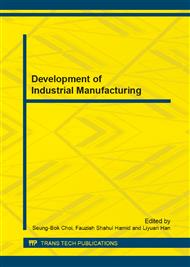p.439
p.443
p.447
p.451
p.457
p.461
p.465
p.469
p.473
Void Prediction of Cement Concrete Overly on Old Cement Pavement after Rubblization
Abstract:
Void is a major disease of cement concrete pavement, and it is also the inducement of other diseases. In order to predict the void, this paper quantificational analyzes the relationship between the times of load function and the lost of materials caused by erosion based on the analysis of the shape and height of void. And then it puts forward that the volume of the lost of materials caused by erosion is equal to the void under slab and gets the prediction models of voids beneath slab corner and along longitudinal joint edge. The results suggest that when the void height is less than side length, the prediction model of void beneath slab corner is same to the along longitudinal joint edge. The development of the void only has relationships with the anti-scour performance of the base course material, the ratio of height and size of void, and the times of standard axle load.
Info:
Periodical:
Pages:
457-460
Citation:
Online since:
February 2014
Authors:
Price:
Сopyright:
© 2014 Trans Tech Publications Ltd. All Rights Reserved
Share:
Citation:


